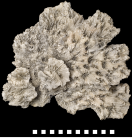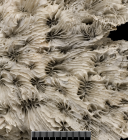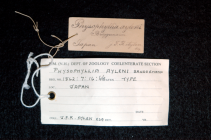WoRMS taxon details
Physophyllia Duncan, 1884
205539 (urn:lsid:marinespecies.org:taxname:205539)
accepted
Genus
Pectinia ayleni Wells, 1935 accepted as Physophyllia ayleni (Wells, 1935) (type by subsequent designation)
- Species Physophyllia ayleni (Wells, 1935)
- Species Physophyllia patula Hodgson & Ross, 1982 accepted as Echinophyllia patula (Hodgson & Ross, 1982) (unaccepted > superseded combination, basionym)
- Species Physophyllia wellsi Nemenzo, 1971 accepted as Physophyllia ayleni (Wells, 1935) (unaccepted > junior subjective synonym)
marine, fresh, terrestrial
Duncan PM (1884) A revision of the families and genera of the sclerodermic Zoantharia, Ed. & H., or Madreporaria (M. Rugosa excepted). Journal of the Linnean Society of London, 18: 1-204. [details]
Description 'Colony large, spreading, pedunculate, foliaceous, folia united and presenting faint broad ridges, which are crossed by...
Description Colonies are plate-like, combining many of the characters of Pectinia and Echinophyllia. Corallites are widely spaced, open...
Description 'Colony large, spreading, pedunculate, foliaceous, folia united and presenting faint broad ridges, which are crossed by septocostae. Corallites low, wide apart, arranged more or less in concentric circles. Calices distant, large, sunken, deep, elongate, forming series of 2 to 4, or circular. Fossa large and deep. Columella small, trabeculate. Septa large, exsert, spinulose, especially near the axis, unequal, wide apart; ending in septocostae which are confluent with those of the calices on either side, and some of which pass over broad ridges radially. Intercalicular surface large, gibbous or ridged, formed of convex vesicular endotheca; this endotheca fills up the interseptal loculi also, and is greatly developed. Calices on one side of the colony only. Common wall inferior, costulate to the base. Costae distinct, spinulose. No epitheca. Fissiparity occurs, and also gemmation.' (Duncan, 1884: 118) [details]
Description Colonies are plate-like, combining many of the characters of Pectinia and Echinophyllia. Corallites are widely spaced, open...
Description Colonies are plate-like, combining many of the characters of Pectinia and Echinophyllia. Corallites are widely spaced, open and shallow. The coenosteum is thin and blistery and tends to develop Pectinia-like walls (Veron, 1986 <57>). [details]
Hoeksema, B. W.; Cairns, S. (2024). World List of Scleractinia. Physophyllia Duncan, 1884. Accessed through: World Register of Marine Species at: https://www.marinespecies.org/aphia.php?p=taxdetails&id=205539 on 2024-04-20
Date
action
by
1998-06-04 11:18:58Z
changed
Depew, Lorna
2006-09-27 07:06:07Z
changed
Martinez, Olga
![]() The webpage text is licensed under a Creative Commons Attribution 4.0 License
The webpage text is licensed under a Creative Commons Attribution 4.0 License
original description
Duncan PM (1884) A revision of the families and genera of the sclerodermic Zoantharia, Ed. & H., or Madreporaria (M. Rugosa excepted). Journal of the Linnean Society of London, 18: 1-204. [details]
context source (Hexacorallia) Fautin, Daphne G. (2013). Hexacorallians of the World. (look up in IMIS) [details]
basis of record Veron JEN. (1986). Corals of Australia and the Indo-Pacific. <em>Angus & Robertson Publishers.</em> [details]
additional source Huang D, Benzoni F, Fukami H, Knowlton N, Smith ND, Budd AF (2014) Taxonomic classification of the reef coral families Merulinidae, Montastraeidae, and Diploastraeidae (Cnidaria: Anthozoa: Scleractinia). Zoological Journal of the Linnean Society 171: 277–355. [details]
additional source Dunn, D. F. (1982). Cnidaria. McGraw-Hill Book Company. New York and other cities., volume 1, pp. 669-706
page(s): 702 [details]
additional source Neave, Sheffield Airey. (1939-1996). Nomenclator Zoologicus vol. 1-10 Online. <em>[Online Nomenclator Zoologicus at Checklistbank. Ubio link has gone].</em> , available online at https://www.checklistbank.org/dataset/126539/about [details]
context source (Hexacorallia) Fautin, Daphne G. (2013). Hexacorallians of the World. (look up in IMIS) [details]
basis of record Veron JEN. (1986). Corals of Australia and the Indo-Pacific. <em>Angus & Robertson Publishers.</em> [details]
additional source Huang D, Benzoni F, Fukami H, Knowlton N, Smith ND, Budd AF (2014) Taxonomic classification of the reef coral families Merulinidae, Montastraeidae, and Diploastraeidae (Cnidaria: Anthozoa: Scleractinia). Zoological Journal of the Linnean Society 171: 277–355. [details]
additional source Dunn, D. F. (1982). Cnidaria. McGraw-Hill Book Company. New York and other cities., volume 1, pp. 669-706
page(s): 702 [details]
additional source Neave, Sheffield Airey. (1939-1996). Nomenclator Zoologicus vol. 1-10 Online. <em>[Online Nomenclator Zoologicus at Checklistbank. Ubio link has gone].</em> , available online at https://www.checklistbank.org/dataset/126539/about [details]
 Present
Present  Inaccurate
Inaccurate  Introduced: alien
Introduced: alien  Containing type locality
Containing type locality
From editor or global species database
Comparison Based on an examination of the type material of Physophyllia ayleni, the genus shares all macromorphological characters studied here with Pectinia and Mycedium. Note that quantitative measurements were based on peripheral corallites as some structures of the central corallite, such as the columella, may be extremely large in comparison. Although we recognize Physophyllia as distinct from Pectinia and Mycedium, subcorallite morphology and/or DNA sequence data will reveal the accuracy of this interpretation. The latter two genera are indistinguishable for all of the characters used for the present analysis, but they arguably span a wide range of morphologies not coded into phylogenetic data. The coenosteum of Physophyllia is made up of large ridges filled with vesicular endotheca, and do not form upwardly projecting laminae seen in most Pectinia species. Its corallites are also not distinctly inclined towards the periphery of the colony, a clear distinction from Mycedium. If Physophyllia is indeed separable from either of them based on the same molecular markers employed, it would likely be recovered outside of the Pectinia + Mycedium clade, and subcorallite disparities could be expected. [details]Description 'Colony large, spreading, pedunculate, foliaceous, folia united and presenting faint broad ridges, which are crossed by septocostae. Corallites low, wide apart, arranged more or less in concentric circles. Calices distant, large, sunken, deep, elongate, forming series of 2 to 4, or circular. Fossa large and deep. Columella small, trabeculate. Septa large, exsert, spinulose, especially near the axis, unequal, wide apart; ending in septocostae which are confluent with those of the calices on either side, and some of which pass over broad ridges radially. Intercalicular surface large, gibbous or ridged, formed of convex vesicular endotheca; this endotheca fills up the interseptal loculi also, and is greatly developed. Calices on one side of the colony only. Common wall inferior, costulate to the base. Costae distinct, spinulose. No epitheca. Fissiparity occurs, and also gemmation.' (Duncan, 1884: 118) [details]
Diagnosis Colonial, with intracalicular budding only. Corallites polymorphic and organically united; monticules absent. Coenosteum costate, extensive amount (≥ corallite diameter). Calice width medium (4–15 mm), with medium relief (3–6 mm). Costosepta confluent. Septa in 3 cycles (24–36 septa). Free septa present but irregular. Septa spaced < 6 septa per 5 mm. Costosepta unequal in relative thickness. Columellae trabecular and spongy (> 3 threads), < 1/4 of calice width, and discontinuous among adjacent corallites (lamellar linkage). Paliform (uniaxial) lobes weak or moderate. Epitheca absent and endotheca abundant (vesicular). [details]
Remark This is a monotypic genus with Physophyllia ayleni as its sole member. The species was placed in Pectinia by Veron, 2000, vol. 2: 352 based on his collection, presumably shown in figs 1–3. These are however distinct from the type material studied by Wells, 1935: 342 and thus have been described as Pectinia crassa Ditlev, 2003: 204, figs 13–15 with material from Sabah. [details]
From other sources
Description Colonies are plate-like, combining many of the characters of Pectinia and Echinophyllia. Corallites are widely spaced, open and shallow. The coenosteum is thin and blistery and tends to develop Pectinia-like walls (Veron, 1986 <57>). [details]
| Language | Name | |
|---|---|---|
| Japanese | ウミバラ属 | [details] |


